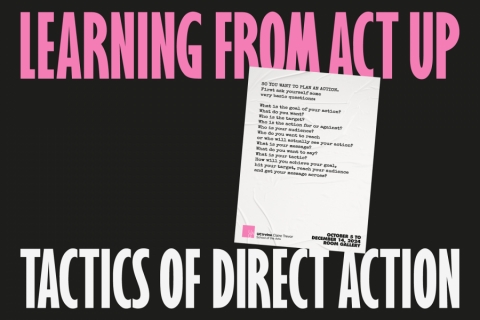Learning from ACT UP: Tactics of Direct Action
Learning from ACT UP: Tactics of Direct Action
Learning from ACT UP: Tactics of Direct Action
Curated by Juli Carson and Sasha Ussef
Exhibition design by Richard Kahwagi
Oct. 5-Dec. 14, 2024 (Hours: 12-6 p.m.)
Opening Reception: Saturday, Oct. 5, 2-6 p.m.
Room Gallery
So, you want to plan an action.
We live in tumultuous times. There are culture wars the likes of which we haven’t seen since the 1980s. Looming even larger is a pernicious anti-democratic turn—in both the US and abroad—that’s instilled a general sense of dread whenever elections approach. Unsurprisingly, there’s a strong desire to organize, act, and make positive change. To be the protagonist of an empowering counter-narrative. Learning from ACT UP: Tactics of Direct Action is a performative installation—comprised of film, graphics, and archival material—that demonstrate what dogged but peaceful civil disobedience might achieve. How, in fact, it might even change the world.
Our case-study protagonist is ACT UP, the AIDS Coalition to Unleash Power. Founded in March 1987, ACT UP defined itself as “a diverse, nonpartisan group united in anger and committed to direct action to end the AIDS crisis.” Their first “act” was the adoption of the famed graphic emblem SILENCE=DEATH, printed in white Gill sanserif type underneath a pink triangle on a black background, which came to signify a global community set on confronting the engines of the AIDS crisis: homophobic ideologies, government inaction, and outmoded medical protocols. Learning from ACT UP, by focusing on the actions initiated by the founding New York chapter from 1987-1993, performatively shows how one might react to a social crisis, reach a broad audience, change the discourse of “business as usual,” and initiate systemic change.
The endgame of systemic change is no small feat. It entails collective organization—the building of a counterinstitution itself, albeit one that’s contingent with no given “leader.” Towards this end, ACT UP held regular Monday night meetings run with Robert’s Rules of Order. Agendas were set by the Coordinating Committee. Facilitators ran the meetings moving discussion towards various actions, in coordination with focus committees—Fundraising, Treatment and Data, Majority Action, People of Color, Media, key among them. Simultaneously, other people self-divided into affinity groups not accountable to the larger body. Sarah Schulman recounts in her book Let the Record Show, “When the Monday-night general meeting decided to do an action at the FDA, it was organized through the Actions Committee, sitting at the Coordinating Committee. But at the demonstration, individual affinity groups appeared with their own artistic and creating expression that no one had approved.”
If this all seems daunting, really, it’s not.
Alongside a timeline of other zaps and actions that forced the government and mainstream media to confront the AIDS crisis, Learning from ACT UP features United in Anger: A History of ACT UP, a documentary that reveals the group’s complex culture of meetings, affinity groups, and approaches to civil disobedience, on any given Monday night. Combining archival footage from activists, and interviews from the ACT UP Oral History Project, the film further explores ACT UP from a grassroots perspective and through the planning and execution of major actions including Seize Control of the FDA, Stop the Church, and Day of Desperation. Beating at the heart of United in Anger is the simultaneous grief, camp, and sexiness that defined ACT UP’s heterodoxic energy, a tenacious life drive intent on slaying the death drive from which the group originated. In these tumultuous times, this is a lesson we must learn from ACT UP.
Curator Bios:
Juli Carson is Professor of Art, Theory and Criticism in the Department of Art at UC Irvine and Director of the University Art Galleries. From 2018-19 she was the Philippe Jabre Professor of Art History and Curating at the American University of Beirut. Her books include: Exile of the Imaginary: Politics, Aesthetics, Love (Vienna: Generali Foundation, 2007) and The Limits of Representation: Psychoanalysis and Critical Aesthetics (Buenos Aires: Letra Viva Press, 2011). Her two most recent books are The Hermeneutic Impulse: Aesthetics of an Untethered Past (Berlin: b_books, 2019) and Mary Kelly’s Concentric Pedagogy: Selected Writings (UK: Bloomsbury Press, 2024).
Sasha Ussef is the Associate Director of the University Art Galleries at the University of California, Irvine. She received a Masters in Urban Planning and an MA in Art and Curatorial Practices in the Public Sphere from the University of Southern California. She has taken on curatorial and programming positions at the Sursock Museum in Beirut and the Vincent Price Art Museum in Los Angeles.
Image credit: Poster by Richard Kahwagi
Department of Art: 949-824-4917 | art.arts.uci.edu | StuArt@uci.edu
University Art Galleries: 949-824-9854 | uag.art.arts.uci.edu | gallery@uci.edu
Gallery hours: Tuesday-Saturday, noon-6 p.m.
Gallery hours are subject to change, please check the gallery website for up to date information.
Free admission
| Know Before You Go Helpful hints for your visits including parking, directions, and more! |
Please visit our secure direct giving page and make a gift to support the Department of Art today!
Make a Gift


